The Dark-billed Cuckoo, scientifically known as Coccyzus melacoryphus, is a captivating avian species found in various regions of South America. Renowned for its distinctive dark bill, this medium-sized cuckoo boasts a unique and eye-catching appearance.
Its plumage is predominantly brown with subtle patterns, contributing to its discreet yet elegant presence in its natural habitat.
Known for its vocalizations, the Dark-billed Cuckoo produces a series of melodious calls that resonate through the lush canopies it inhabits.
As an arboreal species, it predominantly dwells in wooded areas, demonstrating a preference for dense foliage. This species is an integral part of the ecosystems it inhabits, playing a role in insect control as it primarily feeds on insects and caterpillars.
The Dark-billed Cuckoo is a testament to South American avifauna’s rich biodiversity, captivating bird enthusiasts and researchers alike with its unique features and ecological significance.
Identification Criteria of Dark-billed Cuckoo
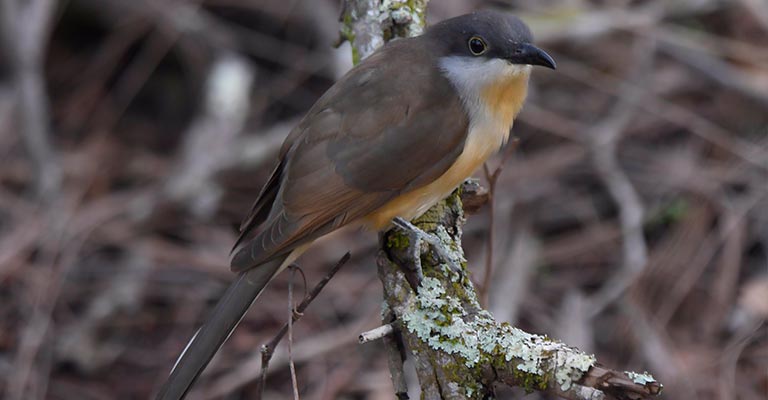
Identifying the Dark-billed Cuckoo (Coccyzus melacoryphus) requires keenly observing its distinctive features, behaviors, and habitat. Here are eight key identification criteria to help distinguish this intriguing bird:
Distinctive Dark Bill
The most striking feature of the Dark-billed Cuckoo is its namesake – the dark bill. The bill is notably darker than the rest of its plumage, appearing almost black.
This characteristic sets it apart from other cuckoo species and is crucial in initial identification.
Medium-sized Cuckoo with Subtle Plumage
The Dark-billed Cuckoo is a medium-sized bird, typically measuring around 28-33 centimeters in length. Its plumage is predominantly brown, showcasing a subtle blend of shades that aids camouflage within its wooded habitat.
While not flashy in appearance, the understated elegance of its plumage is a defining trait.
Distinctive Vocalizations
Recognizing the bird by its vocalizations is essential. The Dark-billed Cuckoo produces a series of distinctive calls, including melodious whistles and guttural croaks.
Familiarizing oneself with these vocalizations can significantly aid in identifying the bird, especially when visual confirmation is challenging.
Woodland Habitat Preference
Understanding the Dark-billed Cuckoo’s habitat preference is crucial for identification. This species predominantly resides in wooded areas, favoring forests with dense canopies.
It is often found in both primary and secondary forests, where it can utilize the cover of foliage for foraging and nesting.
Arboreal Behavior
The Dark-billed Cuckoo exhibits arboreal behavior, spending much of its time in the upper reaches of trees.
Observing its preference for perching on branches and moving through the canopy indicates its species. This species is more closely associated with the tree canopy than ground-dwelling cuckoos.
Insectivorous Diet
The Dark-billed Cuckoo sustains itself primarily through an insectivorous diet. It preys on insects, caterpillars, and other arthropods in its woodland habitat.
This feeding behavior can be observed as it actively forages for prey among the leaves and branches.
Geographic Range
Lastly, considering the geographic range is essential. The Dark-billed Cuckoo is primarily found in South America, ranging from Venezuela and Colombia to Argentina and Chile.
Familiarizing oneself with its specific distribution can help avoid misidentification with similar cuckoo species in other regions.
A comprehensive identification of the Dark-billed Cuckoo involves a combination of visual, auditory, and ecological cues.
Birdwatchers and ornithologists can enhance their ability to accurately identify this species by paying attention to its unique interplay of its dark bill, subtle plumage, vocalizations, nesting strategies, and geographic range.
Taxonomy of Dark-billed Cuckoo
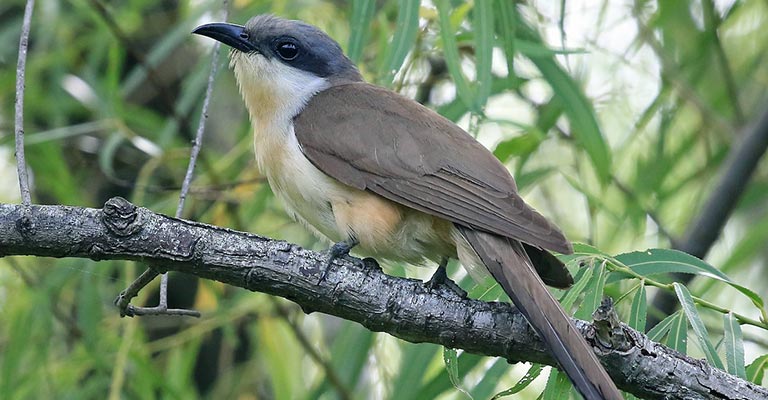
This table will summarize the taxonomy details of the Dark-billed Cuckoo (C. melacoryphus):
| Taxonomic Level | Classification |
| Domain | Eukaryota |
| Kingdom | Animalia |
| Phylum | Chordata |
| Class | Aves |
| Order | Cuculiformes |
| Family | Cuculidae |
| Genus | Coccyzus |
| Species | C. melacoryphus |
The Dark-billed Cuckoo (Coccyzus melacoryphus) belongs to the Cuculidae family, a diverse group of birds known as cuckoos.
Coccyzus’s genus includes various cuckoo species characterized by medium size, long tails, and distinctive vocalizations. As a member of the Aves class, the Dark-billed Cuckoo is part of the broader bird taxonomy.
Its specific epithet, melacoryphus, reflects its unique dark bill. Within the taxonomic hierarchy, it falls under the order Cuculiformes, encompassing a variety of cuckoos and turacos.
Understanding the bird’s taxonomy provides insights into its evolutionary relationships and biological classification among avian species.
Dark-billed Cuckoo Life History
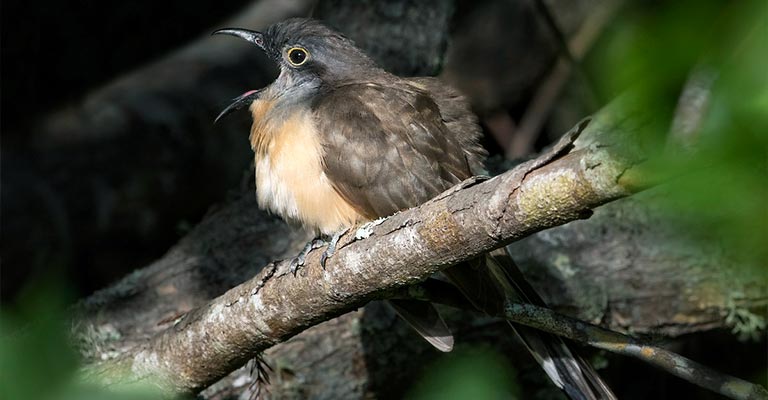
The life history of the Dark-billed Cuckoo (Coccyzus melacoryphus) unveils a fascinating narrative of survival, adaptation, and ecological interdependence.
This medium-sized cuckoo, native to the diverse landscapes of South America, exhibits distinctive traits in its feeding habits, habitat preferences, breeding strategies, and encounters with diseases.
Understanding its life history sheds light on the intricate web of ecological relationships that contribute to its existence and the challenges it faces in the realm of conservation.
Food
The Dark-billed Cuckoo sustains itself through an insectivorous diet, primarily feeding on insects and caterpillars. Its adept foraging skills are crucial for maintaining a delicate balance within its ecosystem.
This dietary preference not only regulates insect populations but also positions the bird as a significant contributor to the overall health of the forest ecosystem.
Habitat
This species thrives in wooded habitats, favoring forests with dense canopies. The Dark-billed Cuckoo is notably arboreal, spending a significant portion of its life in the upper branches of trees.
This habitat preference aligns with its foraging behavior, as it seeks prey among the leaves and branches, showcasing a harmonious adaptation to the intricacies of the forest environment.
Range Map
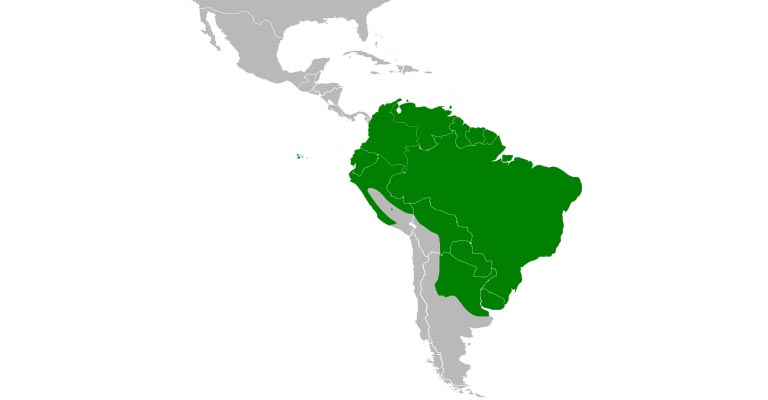
The Dark-billed Cuckoo’s geographic range spans South America, from Venezuela and Colombia to Argentina and Chile.
Its distribution is intricately connected to the availability of suitable habitats, emphasizing the importance of preserving diverse ecosystems across this expansive region.
Breeding
Breeding behavior involves the concealment of nests within dense vegetation. The cryptic nesting strategy aims to protect offspring from potential predators.
During the breeding season, the species engage in courtship displays and vocalizations, contributing to the complex orchestration of avian reproductive behaviors.
Diseases
While specific diseases affecting the Dark-billed Cuckoo may vary, avian diseases such as avian influenza, parasites, and respiratory infections can pose threats.
Monitoring and understanding these potential health challenges is vital for the overall well-being of the species.
Treatment
Veterinary intervention and conservation efforts play a crucial role in addressing potential health issues.
Treatment protocols may involve habitat preservation, disease monitoring, and public awareness programs to mitigate threats and ensure the long-term health of Dark-billed Cuckoo populations.
Conservation
Preserving the Dark-billed Cuckoo and its habitat is essential for maintaining biodiversity in South America.
Conservation efforts include safeguarding forests, implementing sustainable land-use practices, and raising awareness about the bird’s ecological importance.
Collaborative initiatives involving local communities, scientists, and policymakers contribute to the overarching goal of ensuring the continued existence of this unique cuckoo species.
The life history of the Dark-billed Cuckoo reflects its integral role in the intricate tapestry of South American ecosystems.
From foraging in dense canopies to navigating the challenges of breeding and potential health threats, this species encapsulates the delicate balance of nature.
Conservation endeavors are pivotal in safeguarding the Dark-billed Cuckoo, ensuring its continued presence as a testament to the biodiversity and interconnectedness of the natural world.
Nesting Habit of Dark-billed Cuckoo
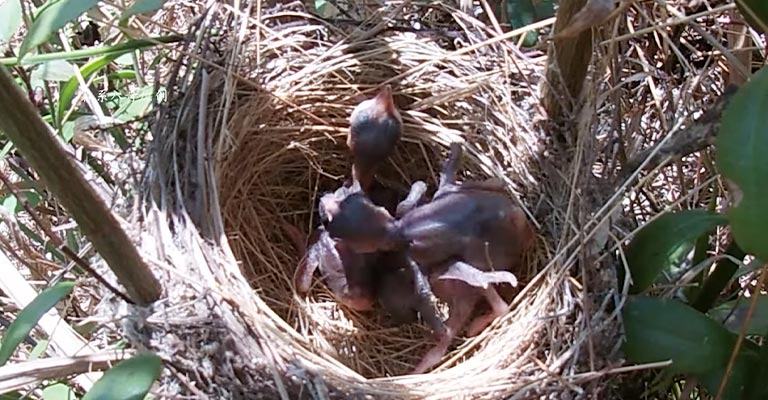
The Dark-billed Cuckoo (Coccyzus melacoryphus) adopts a discreet and cryptic nesting strategy, concealing its nests within dense vegetation.
This arboreal species, prevalent in South American forests, carefully selects locations amidst the foliage to safeguard its offspring from potential predators.
During the breeding season, the Dark-billed Cuckoo engages in courtship displays and vocalizations to establish pair bonds. The female then constructs a cup-shaped nest using twigs, leaves, and other plant materials, blending seamlessly with the surroundings.
This concealed nesting behavior aligns with the bird’s preference for wooded habitats and contributes to successfully rearing its young.
| Nesting Parameter | Details |
| Clutch Size | Typically 2-3 eggs |
| Number of Broods | Often raises a single brood per breeding season |
| Egg Length | Approximately 24-27 mm |
| Egg Width | Approximately 17-19 mm |
| Incubation Period | Around 11-14 days |
| Nestling Period | Approximately 12-15 days |
| Egg Description | Smooth and slightly glossy; pale in color with minimal markings |
10 Behavioral Habits of Yellow-billed Cuckoo
The Yellow-billed Cuckoo (Coccyzus americanus) is a captivating bird species known for its unique behaviors, contributing to its ecological significance.
Native to North and Central America, this medium-sized cuckoo exhibits distinctive habits that span various aspects of its life, from foraging and vocalizations to migration and nesting behaviors.
Understanding these behavioral traits provides insight into the adaptability and role of the Yellow-billed Cuckoo within its diverse habitats.
Foraging Mastery
Yellow-billed Cuckoos are adept foragers specializing in catching large insects like caterpillars and cicadas. Their slender bills and agile movements facilitate efficient prey capture.
Cryptic Behavior
Known for their cryptic behavior, Yellow-billed Cuckoos often remain inconspicuous in dense foliage, relying on their mottled plumage for camouflage.
This behavior aids in both foraging and avoiding potential predators.
Distinctive Vocalizations
The cuckoo’s call, a distinctive “kowp-kowp-kowp,” resonates through woodlands during the breeding season. Vocalizations serve multiple purposes, including territory establishment and mate attraction.
Nomadic Nature
Yellow-billed Cuckoos exhibit a nomadic lifestyle with irregular migration patterns. Food availability often influences their movements, making them adaptable to diverse ecosystems.
Frequent Wing Spreading
A notable behavior is the frequent spreading of wings, which is believed to aid in temperature regulation. This behavior is particularly pronounced during warmer weather.
Brood Parasitism
Yellow-billed Cuckoos occasionally engage in brood parasitism, laying their eggs in the nests of other bird species. This strategy allows them to allocate more energy foraging and less to nest-building.
Territorial Displays
During the breeding season, territorial displays involve wing flicking, tail fanning, and bill snapping. These displays communicate dominance and help establish and defend breeding territories.
Migratory Movements
Although their migratory patterns are not entirely predictable, Yellow-billed Cuckoos undertake long-distance migrations, traveling to their breeding grounds in North America and wintering in Central and South America.
The behavioral habits of the Yellow-billed Cuckoo unveil a rich tapestry of adaptations and strategies that enable its survival in diverse environments.
From secretive foraging to nomadic movements and intricate nesting behaviors, these habits underscore the species’ resilience and ecological importance within its range.
Wrapping Up
In the intricate realm of avian ecology, the Dark-billed Cuckoo stands as a testament to nature’s adaptability and interconnectedness.
From its distinctive dark bill to arboreal foraging and concealed nesting, each aspect of its life history reflects a finely tuned adaptation to South American habitats.
The efforts to understand, appreciate, and conserve this species contribute not only to the preservation of a unique bird but also to the delicate balance of ecosystems it calls home.
As we delve into the nuances of the Dark-billed Cuckoo’s existence, we uncover a compelling story of survival, reproduction, and the intricate dance between this avian species and the vast landscapes it inhabits.